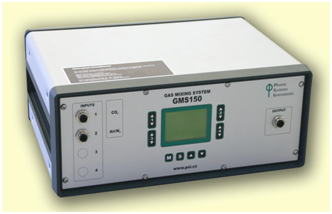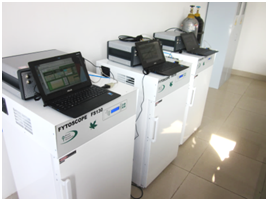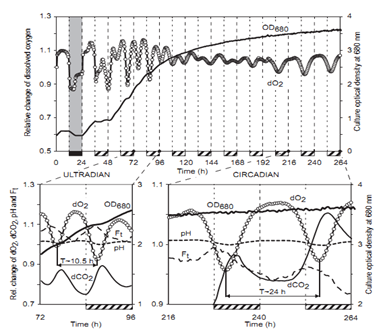GMS150高精度气体调控系统
GMS150高精度气体调控系统可以将多4种不同气体进行精确混合。每路输入气体的流量使用热式质量流量计精确测量,并由内置的质量流量控制器进行控制,输出的是完全混合的均质气体。气体输入输出使用Prestolok快速安全接头,保证使用过程中的便捷性与安全性。
GMS150高精度气体调控系统可用于二氧化碳、氮气、一氧化碳、甲烷、氨气以及其他气体的浓度控制。
GMS150高精度气体调控系统分为GMS150版和GMS150-MICRO版,其中GMS150版精度更高,GMS150-MICRO版可调控流速更大。


应用领域:
与植物培养箱、光养生物反应器等联用,进行精确气体控制培养
模拟不同CO2浓度环境,研究温室效应对植物/藻类的影响
研究CO2浓度与光合作用的关系
模拟烟气等有害气体对植物/藻类的影响
研究植物/藻类对有害气体的处理与利用
技术参数:
测量原理:热式质量流量测量法
可调控气体:空气、氮气、二氧化碳、氧气、一氧化碳、甲烷、氨气等干燥纯净、无腐蚀性、无爆炸性气体,气源需用户自备
调控通道:标配为2通道,通道1为Air-N2,通道2为CO2,多可扩展为4通道
工作温度:15-50℃
输入/输出接头:Parker Prestolok接头(6mm)
输入压力:3-5bar
密封:氟化橡胶
显示屏:8×21字符液晶显示屏
尺寸:37cm×28×15cm
供电:115-230V交流电
可联用仪器:FMT150藻类培养与在线监测系统、MC1000 8通道藻类培养与在线监测系统、FytoScope系列智能LED光源生长箱、用户自行设计的培养箱或反应器(可提供气路连接方案)等
|  |
与FMT150藻类培养与在线监测系统联用的GMS150 | 与FytoScope智能LED光源生长箱联用的GMS150 |
| |
与中科院海洋所自行设计的培养装置联用的GMS150 | |
GMS150版调控参数:
小流量范围:0.02-1 ml/min
流量范围:20-1000ml/min
可定制流量范围:可在流量和小流量之间定制。标准配置通道1(Air-N2): 20-1000 ml/min;通道2(CO2): 0.4-20 ml/min;可调控CO2浓度0.04% - (实际调控浓度与流量有关)
精度:±0.5%,加全量程±0.1%(3-5ml/min为全量程±1%,<3ml/min为全量程±2%)
稳定性:<全量程±0.1%(参考1ml/min N2)
稳定时间:1~2s
预热时间:30min预热达到精度,2min预热偏差±2%
温度灵敏度:<0.05%/℃
压力灵敏度:0.1%/bar(参考N2)
姿态灵敏度:1bar 压力下与水平面保持90°误差0.2%(参考N2)
重量:7kg
GMS150-MICRO版调控参数:
小流量范围:0.2 - 10 ml/min
流量范围:100 - 5000 ml/min
可定制流量范围:可在流量和小流量之间定制。标准配置通道1(Air-N2): 40-2000 ml/min;通道2(CO2): 0.8-40 ml/min;可调控CO2浓度0.04% - (实际调控浓度与流量有关)
精度:±1.5%,加全量程±0.5%
重复性:流量<20 ml/min为全量程±0.5%,流量>20 ml/min为实际流量±0.5%
稳定时间:1s
预热时间:30min预热达到精度,2min预热偏差±2%
温度灵敏度:零点<0.01%/℃,满度<0.02%/℃
姿态灵敏度:1bar 压力下与水平面保持90°误差0.5 ml/min(参考N2)
重量:5kg
应用案例:


与FMT150藻类培养与在线监测系统联用研究蓝藻Cyanothece sp. ATCC 51142 的超日代谢节律(Cervený, 2013, PNAS)
产地:欧洲
参考文献:
1. Strenkert D, et al. 2019. Multiomics resolution of molecular events during a day in the life of Chlamydomonas. PNAS, 116 (6): 2374-2383
2. Sukačová K, et al. 2019.Optimization of microalgal growth and cultivation parameters for increasing bioenergy potential: Case study using the oleaginous microalga Chlorella pyrenoidosa Chick (IPPAS C2). Algal Research40: 101519
3. Cordara A, et al. 2018. Analysis of the light intensity dependence of the growth of Synechocystis and of the light distribution in a photobioreactor energized by 635 nm light. PeerJ, 6:e5256, DOI 10.7717/peerj.5256
4. Cordara A, et al. 2018. Response of the thylakoid proteome of Synechocystis sp. PCC 6803 tophotohinibitory intensities of orange-red light. Plant physiology and biochemistry, 132: 524-534
5. Alphen P, et al. 2018.Increasing the Photoautotrophic Growth Rate of Synechocystis sp. PCC 6803 by Identifying the Limitations of Its Cultivation. Biotechnology Journal13(8):700764
6. Sarayloo E, et al. 2018. Enhancement of the lipid productivity and fatty acid methyl ester profile of Chlorella vulgaris by two rounds of mutagenesis. Bioresource Technology, 250: 764-769
7. Mitchell M C, et al. 2017. Pyrenoid loss impairs carbon-concentrating mechanism induction and alters primary metabolism in Chlamydomonas reinhardtii. Journal of Experimental Botany, 68(14): 3891-3902
8. Hulatt C J, et al. 2017. Polar snow algae as a valuable source of lipids®Bioresource Technology, 235: 338-347
9. Jouhet J, et al. 2017. LC-MS/MS versus TLC plus GC methods: Consistency of glycerolipid and fatty acid profiles in microalgae and higher plant cells and effect of a nitrogen starvation. PLoS ONE 12(8): e0182423
10. Angermayr S A, et al. 2016. Culturing Synechocystis sp. Strain PCC 6803 with N2 and CO2 in a Diel Regime Reveals Multiphase Glycogen Dynamics with Low Maintenance Costs. Appl. Environ. Microbiol., 82(14):4180-4189
11. Acuña A M, et al. 2016. A method to decompose spectral changes in Synechocystis PCC 6803 during light-induced state transitions. Photosynthesis Research, 130(1-3): 237-249